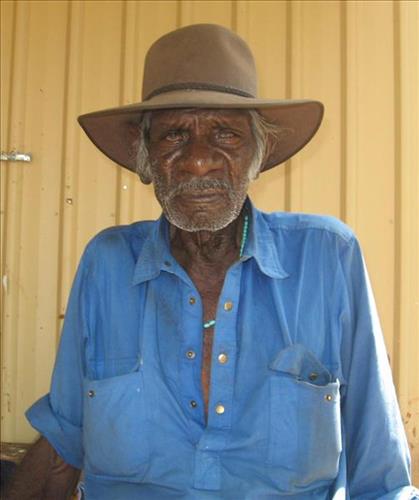Biography:
Rusty Peters was a senior Gija man of Juwurru skin. His bush name Dirrji refers to dingo pups looking out of a hole at the sunrise. He was born under a Warlagarri or Supplejack tree on Springvale Station south west of Turkey Creek the same day as his jimarri or age mate Charlie McAdam. His spirit came from a crocodile his father had killed when his mother became pregnant.
He grew up on Springvale learning traditional law and working as a stockman and at other things such as welding fences and stock yards. When his father was killed in a tragic riding accident at Roses Yard, the family moved to Mabel Downs where he became renowned as a horse breaker. He lived for some time at Nine Mile reserve at Wyndham after the introduction of award wages forced people off stations but then moved to Turkey Creek where with other senior Gija artists such as Hector Jandany and George Mung-Mung he helped start the school. He remained an inspiration leader in Gija cultural education, and contributed much of his time and energy in ensuring that the Gija children of Warrmarn were connected to their culture. Up until his last days, he advocated for Gija language and culture within the school program.
As part of the Gija cultural program, he took groups of boys out bush, showed them how to make spears and hunt and to make a camp without matches or blankets in the traditional way. He also worked in the Gija language maintenance program. In 1989 he moved to Kununurra where he was employed at Waringarri Aboriginal Arts as an assistant. He working stretching canvases in the studio as an artsworker. He was also a long time friend of Rover Thomas, caring for him on most of the trips he made in the later part of his life. He made prints and did some painting while working for Waringarri Arts.
He moved to Crocodile Hole when Freddie Timms based the Jirrawun Aboriginal Arts group there in 1997 and began to paint on large canvases. His detailed knowledge of the land and stories from Springvale and neighbouring Moolabulla stations is reflected in distinctive paintings in traditional red and yellow ochres and black charcoal. While recognisably part of the 'Turkey Creek' style the intricate curves mapping the country and the dark caves and rivers in the pictures are particular to Rusty's work. In early 2000 he collaborated with Peter Adsett, a white artist from the Northern Territory University. Each artist completed seven canvases taking turns to paint in response to each other. These paintings were shown at a joint exhibition "Two Laws, One Big Spirit" at 24Hour Art, Darwin in September 2000. The Neminuwarlin dance group performed at the exhibition's closing ceremony. This acclaimed exhibition toured Australia during 2002-2004.
Rusty's painting Chinaman Garden Massacre, which tells the story of yet another tragic piece of East Kimberley history, was purchased by the Art Gallery of New South Wales in March 2001. This painting together with another work by Rusty's, Blackfella Murdered in Australia, were included in the Blood on the Spinifex exhibition at the Ian Potter Museum of Art at the University of Melbourne between December 2002 and March 2003. His eight panel painting ‘Waterbrain’ was acquired by the Art Gallery of NSW in February 2002 and featured in their True Stories: Art of the East Kimberley in early 2003. Rusty Peters has returned to paint with Warmun Art Centre in 2010 after the closure of Jirrawun Art.
In 2015, Rusty was a finalist in the 32nd Telstra National Aboriginal and Torres Strait Islander Art Award, and in 2017, three of his paintings were featured in Defying Empire, the exhibition of the 3rd National Indigenous Art Triennial at the National Gallery of Australia Canberra, and later at the Museum and Art Gallery of the Northern Territory. In 2018, in his eighties, Rusty painted a 5-metre triptych depicting his inimitable East Kimberley night starry skies over Darrajayin, his ancestral land. The beautiful and moving painting was acquired by ARTBANK, an entity of the Australian Government specialised in loaning and rotating the works of Australian artists in private and public institutions.
In 2019, Rusty was featured in a major duo exhibition "Stories of Garnkiny" alongside his sister Mabel Juli at Raft Artspace in Alice Springs. His painting "Rocky River Country - Darrajayin" was later acquired by the Australian Parliament House in Canberra through that exhibition. Mr. Peters was also crowned the People's Choice Award Winner in the 2019 Telstra NATSIAA for his beautiful painting of Garnkiny. The award-winning painting was later acquired by the Wesfarmers Art foundation, to be further enjoyed by the people of Western Australia.
He loved his Country and got very worried when in late 2019, a mining company started to mine thousands of tonnes of Granite. He spent his last days on Earth defending his ancestral lands.
Mr. Peters passed away in the East Kimberley on July 30th 2020. His funeral ceremony was held at the Ngalangangpum School in Warmun on 17th September 2020.
His legacy lives on through his family, community, and cultural contributions he made to the local schools and Art Centre.
Biography written by Frances Kofod and edited by Warmun Art Centre staff.




